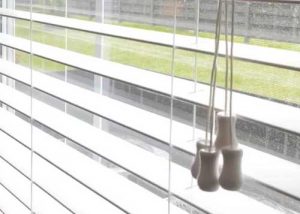 Most homes have them. They help keep our rooms warm or cold and even add a pop of color to tie the décor together. But window blinds can cause serious injuries or even death to young children. A new study from the Center for Injury Research and Policy at Nationwide Children’s Hospital looks at this ongoing cause of injury and fatality and urges the industry to do more for the safety of our children.
Most homes have them. They help keep our rooms warm or cold and even add a pop of color to tie the décor together. But window blinds can cause serious injuries or even death to young children. A new study from the Center for Injury Research and Policy at Nationwide Children’s Hospital looks at this ongoing cause of injury and fatality and urges the industry to do more for the safety of our children.
The study, published today in Pediatrics, found that almost 17,000 children under six years of age were treated in hospital emergency departments in the U.S. for window blind-related injuries from 1990 through 2015, averaging almost two per day. While the majority of children were treated and released, there was about one child death each month – most from strangulation when a child became entangled by the neck in a window blind cord.
The dangers come from inner cords such as those found in horizontal blinds and roman shades, operating cords used to raise and lower the blinds, continuous loop cords such as those found in vertical and roll up shades, or even from loops created by consumers after installation – when cords become knotted or tangled, or when they are tied to a stationary object in an attempt to keep them out of a child’s reach.
“There is a misperception that if we just watch our kids carefully, they will be safe. But even the best parent in the world cannot watch their child every second of every day,” said Gary Smith, MD, DrPH, senior author of this study and director of the Center for Injury Research and Policy at Nationwide Children’s Hospital. “A curious child can quickly get entangled in a window blind cord. This can lead to strangulation within minutes, and the parent may not hear a thing because the child often can’t make a sound while this is happening.”[xyz-ihs snippet=”Adsense-responsive”]The dangers of blind cords peak between 1 to 4 years of age as toddlers gain mobility and become curious about their surroundings. They are able to reach blind cords, but they do not understand the danger of strangulation and are unable to free themselves once entangled. Most injuries in the study occurred while a child was under a parent’s care and had been left alone for less than 10 minutes while either going to sleep, playing, or watching TV.
“It is unacceptable that children are still dying from window blind cord strangulation,” said Dr. Smith. “We have known about this problem since the 1940s. The risk reduction approaches offered by the current voluntary safety standards are not enough. It is time to eliminate the hazard. Safe, affordable cordless blinds and shades are widely available. A mandatory federal safety standard should be adopted prohibiting the sale of products with accessible cords.”
Until all window blinds are cordless, parents should follow these recommendations to reduce the risk of window blind-related strangulation.
- Replace. The best way to keep your children safe is to replace all blinds that have cords with either cordless blinds, blinds with inaccessible cords, or other types of cordless window coverings, such as interior window shutters, draperies, and curtains.
- If you are unable to replace or remove all of your window blinds with cords at one time, start with the windows in the rooms where your child spends the most time – usually bedrooms and living rooms – and replace the others as you can.
- Retrofit. Retrofit kits to address some types of cord hazards are available from the manufacturer. While the fixes provided by these retrofit kits are a good start, remember that removing corded blinds altogether is the best way to protect your child. Some of the fixes can provide a false sense of security if they are not used correctly 100% of the time by everyone who lives in or visits your home.
- Move furniture. Cribs, beds, couches, and other furniture should be moved away from windows so children cannot climb on them to get to the window or window blind cords.
- Every room, every home. Take these steps in every room of the home. Also talk to people at the other places where your child spends time such as the grandparents’ house, child care, or school. Ask them to also remove window blinds with cords to help keep your child safer.
Data for this study were obtained from the National Electronic Injury Surveillance System (NEISS) and In-Depth Investigation (IDI) databases, which are maintained by the U.S. Consumer Product Safety Commission. The NEISS database provides information on consumer product-related injuries treated in hospital emergency departments across the country. The IDI database contains reports from CPSC field investigators, who follow-up on selected consumer product-related incidents.
Source: Nationwide Children’s Hospital




